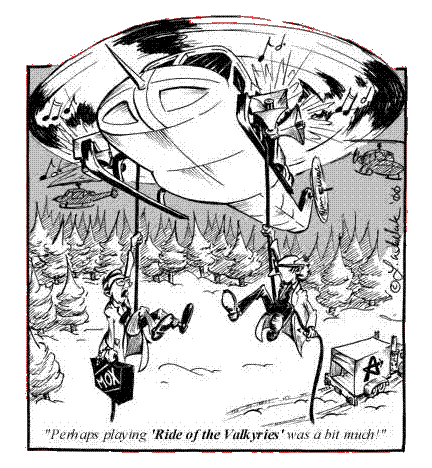Published in the January 2000
issue of the Canadian
Nuclear Society Bulletin, Vol.20, No.4. Artwork
courtesy of Lorne
Whitlock.
ONE FLEW OVER THE CUCKOO'S NEST by Jeremy Whitlock On a frosty Friday in January, AECL and the federal government achieved much more than the simple transport of MOX fuel from Sault Ste. Marie to Chalk River. They achieved something as rare and priceless as a pictograph on Oiseau Rock, and as intangible as a Friday afternoon smile. So rare, in fact, was this ancillary achievement, that observers in the nuclear community had trouble recognizing it at first. Their morale had been boosted. Even as helicopters swept eastward out of the Great Lakes basin and down the Ottawa Valley, bearing their precious yet technically insignificant cargo, workers at Chalk River Laboratories toiled unsuspectingly. True, some had keenly eyed the helicopter by the outer gate that morning. The protective tarpaulin it had worn since appearing several days earlier had conspicuously disappeared, but generally there was no alarm. With heads bent to the winds of January and public contempt, backs shouldering the load of heavy parkas and downsizing, they scurried from building to building, furthering the cause of nature's most almost-perfect energy source.
Clearly, the timing could not have been better. Here was the darkest time of the year just passed, capping months of dispiriting Y2K preparation and vacuous "millennium" discussion, while anti-MOX campaigns waged endlessly in the media. The ancient pagans were wise to schedule a celebration of light and harvest at this time of year, and the Christians were equally wise to co-opt it. Schedule slippage is probably more to credit in the case of the MOX Affair, but a better-timed shot in the arm could scarcely be imagined. It was akin to the spirits of infantry in the trenches, downtrodden by months of muddy stalemate, suddenly uplifted by the sight of a lone lunatic running through the lines clutching the enemy's flag. Here was Jack Nicholson thumbing his nose at Nurse Ratched; Paul Henderson scoring the winning goal; Mad Max driving the tanker truck through the outback. You can get behind a thing like this, even as you shake your head in disbelief. Above all, pro-nuclear observers were struck by the efficacy of the one-two punch. Transporting the MOX by helicopter from the Canadian border was of course an entirely legal and safe manoeuvre, but it also instantly diffused a dozen brewing situations. No aboriginal land was crossed, no Canadian municipality entered (except, briefly, the Soo), and no activist plucked off the road. Protesters were left stammering for something to protest. The government had, after all, done exactly what it said it would do - keep the date secret and notify only emergency personnel. In the end the most substantial complaint was that a similar airborne feat would be illegal in the States, much like universal medicare, gun restrictions, and anything to do with Cuba. Very obviously, the underlying emotion was a sense of being out-flanked and out-witted. The barn door was open and the MOX had bolted. To be honest, observers on this side of the fence were beginning to wonder how it could possibly end in success. Would the government actually have the will to proceed, in the face of certain ugly and protracted engagements that would play out ad nauseum in the media? Many felt that the folly was in the consultation strategy to begin with: the government, heavily lobbied by anti-nuclear groups, had decided that this routine shipment of entirely unremarkable material should be as public as possible. Its failing was the assumption that consensus could be reached where plutonium is involved. You will never, ever get the public to condone plutonium, and town-hall meetings only serve to bring the plutonium more to public attention. Those that do listen and learn, are few. So in the end the government quite plainly had its back against the wall, and everyone knew it. Like doves of freedom, AECL's helicopters flew over that wall, and detoured beyond the CBC's sophomoric "Plutonium Highway". The coup was as undeniable as it was foreboding. As the lone lunatic clutches his precious flag to the sound of renewed shelling and escalated violence, so too will this heroic interlude in Ontario bring only fleeting joy. Mass psychology is as rudimentary as that of a seven-year old, and surely vengeance will be sought in spades for the lost marbles. Nevertheless, truth and reason prevailed for a day. One half of the Parallex MOX is now safely at Chalk River, alongside far more exotic and interesting fuels that the public cares little about. One hopes that the helicopter escapade was bold enough to stimulate serious introspection in the anti-MOX camp. Could plutonium really be safe enough to put on a helicopter? Do radiopharmaceuticals of much greater radioactivity really fly safely on a routine basis in Canada? Perhaps warhead destruction is worthy enough motivation for re-examining one's biases? Could protesters have been used as pawns by anti-MOX leaders with ulterior agendas? Fat chance, but until a better morale-booster comes along for the industry (and one suspects there might be one or two more this year), we'll take what we can get.
| ||||
|
Discussion welcome.
©2011 Jeremy Whitlock
| ||||
|
|

 By the end of the day, they and their colleagues around the country were
exhilarated. The industry that telegraphs its every cautious move months
ahead of time had pulled a "Raid at Entebbe" in the pre-dawn hours.
Employees were as surprised as the activists. Journalists scrambled to
find the right spin for a story that defied all expectation.
By the end of the day, they and their colleagues around the country were
exhilarated. The industry that telegraphs its every cautious move months
ahead of time had pulled a "Raid at Entebbe" in the pre-dawn hours.
Employees were as surprised as the activists. Journalists scrambled to
find the right spin for a story that defied all expectation.